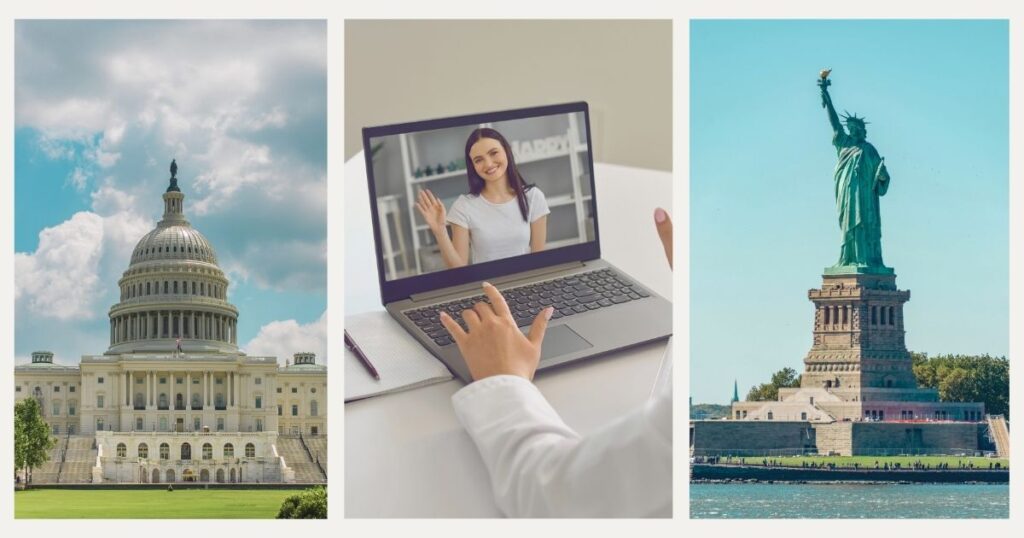Travel insurance in the United States is essential. From navigating sky-high medical costs to covering unexpected emergencies, insurance provides the safety net you need to explore the U.S. worry-free. This guide will help you understand coverage options, plan benefits, and how to select the best policy for your unique needs.
Why travel insurance is essential in the United States

The United States is a hotspot for digital nomads, offering vibrant cities, coworking hubs, and incredible outdoor adventures. But with great opportunities come potential risks, especially regarding health and travel.
1. Medical care costs are sky-high
Medical care in the U.S. is among the most expensive in the world. A hospital stay can easily exceed $10,000, and even routine doctor visits may cost hundreds of dollars. Without travel insurance, you bear these expenses entirely.
2. Emergency protection
Whether it’s food poisoning after sampling Southern barbecue or an accident while cycling in California, emergencies happen. Contracting travel insurance in the United States ensures you’re covered for unexpected medical needs, from ambulance rides to emergency surgeries.
3. Coverage for trip disruptions
Beyond medical emergencies, travel insurance in the United States offers protection against various travel disruptions. Flight cancellations due to weather delays or airline strikes can leave you stranded, but insurance can help cover additional expenses. If your luggage is lost, many policies reimburse you for essential items while you wait for your bags to arrive. Additionally, trip interruption coverage ensures financial protection if you need to return home early due to illness or a family emergency, minimizing unexpected costs and stress during your travels.
🌟 Related resource: learn more about digital nomad resources in the U.S.
What does travel insurance cover in the U.S.?

Not all travel insurance in the United States policies offer the same coverage, so understanding what’s included is essential. Medical and health coverage typically includes emergency treatment for sudden illnesses or injuries, hospitalization for necessary procedures, repatriation if you need to return home due to a serious condition, and prescription drug coverage for medications prescribed during your trip.
Beyond medical care, trip protection safeguards against unexpected disruptions. Policies often cover cancellations or delays, reimbursing prepaid expenses if your plans change. Lost or delayed baggage coverage ensures you can replace essential items, while rental car insurance protects against accidents or theft during your travels.
If your trip involves high-risk activities like skiing or surfing, it’s important to choose a policy that includes adventure sports coverage. Standard insurance may not cover injuries or equipment damage from extreme activities, so selecting the right plan ensures you’re protected no matter where your travels take you.
Choosing the best travel insurance plan for the U.S.

With so many options available, finding the right travel insurance in the United States can be overwhelming. A structured approach helps you choose a plan that fits your needs.
Step 1: Evaluate your travel needs
Consider the length of your stay, as short-term travelers may need different coverage than long-term nomads. Check if your health status requires a plan that includes pre-existing conditions. If you’re planning activities like hiking or sports, make sure your policy covers potential injuries.
Step 2: Compare providers
Look for plans with at least $100,000 in medical coverage, and read the fine print for exclusions. Customer reviews can help identify providers with easy claims processing. Top options include SafetyWing for long-term travelers, World Nomads for adventure coverage, and Allianz for comprehensive protection.
Step 3: Understand the claims process
A good provider should offer 24/7 support, an easy online claims process, and fast reimbursements. Choosing a company with these features ensures smooth assistance if you need medical care or trip protection during your travels.
Costs of travel insurance for the U.S.

Travel insurance in the United States varies in cost depending on several factors.
Factors influencing cost
- Duration: longer trips have higher premiums.
- Age: older travelers may pay more.
- Coverage: higher limits and extras like adventure sports add to the cost.
Average prices
- Short-term plans: $50–$100 for a week.
- Annual multi-trip plans: $400–$700.
🌟 Tip: bundle travel insurance with other services for discounts.
Practical tips for using your travel insurance in the U.S.

Know your policy details
Before your trip, review what your travel insurance in the United States covers, including exclusions and claim procedures. Keep emergency contact numbers handy to ensure quick assistance if needed.
Take proactive steps
Store both digital and physical copies of your policy for easy access. Research nearby hospitals and clinics at your destination in case of emergencies. If you experience theft or loss, file a police report immediately to support your claim.
Common pitfalls to avoid with U.S. travel insurance
Navigating travel insurance in the United States can be complex, with many travelers unknowingly exposing themselves to significant financial risks. Understanding the potential pitfalls is crucial for a worry-free journey through the diverse landscapes and experiences of the United States.
Misunderstanding coverage limits
Coverage limits can be a hidden trap for travelers. In the United States, where medical costs are notoriously high, a seemingly substantial policy might fall short in a real emergency. A $50,000 medical coverage limit can be quickly depleted by a complex medical procedure or extended hospital stay.
🌟 Did you know? The average cost of a three-day hospital stay in the U.S. can exceed $30,000, making comprehensive coverage essential for travelers.
Travelers should meticulously examine their policy’s maximum payout limits, understanding the nuanced differences between medical expense categories. Pay close attention to specific exclusions, deductible amounts, and the fine print regarding emergency medical evacuation. Some policies may appear comprehensive at first glance but contain critical limitations that could leave you financially vulnerable.
💡 Tip: always request a detailed breakdown of coverage from your insurance provider, and don’t hesitate to ask specific questions about potential scenarios you might encounter during your travels.
Overlooking adventure and remote work exclusions

Digital nomads face unique challenges that standard travel insurance often fails to address. Most policies are designed for short-term tourists, not professionals working across multiple locations with specialized equipment needs.
🌟 Did you know? The digital nomad workforce has grown exponentially, with many professionals requiring insurance that goes beyond traditional travel coverage.
The modern traveler needs insurance that understands the complexity of remote work. Consider policies that provide comprehensive protection for work equipment, acknowledge the potential for work-related injuries, and offer flexibility for extended stays. Traditional insurance often creates gaps in coverage that can leave digital professionals exposed to significant financial risks.
💡 Tip: when discussing your policy, be explicit about your work nature, equipment, and travel style to ensure you receive the most appropriate coverage.
Technology and travel insurance: staying connected safely
In today’s digital age, technology is as crucial to travelers as a passport. For digital nomads, staying connected isn’t just a convenience—it’s a lifeline for work and safety.
Digital protection for nomads
Your devices are more than communication tools—they’re essential to your professional and personal life. Traditional travel insurance often provides inadequate digital protection, leaving travelers vulnerable to potential technological disasters.
🌟 Did you know? Cybercrime costs global businesses over $1 trillion annually, making digital protection crucial for travelers.
Look beyond basic device coverage. The ideal insurance should offer comprehensive digital protection, including cyber threat safeguards, emergency data recovery services, and support for identity theft. Your digital ecosystem requires as much protection as your physical belongings.
💡 Tip: consider additional cybersecurity measures like virtual private networks (VPNs) and two-factor authentication to complement your insurance coverage.
Staying connected on the go
Reliable connectivity is a necessity for modern travelers. Complement your insurance with robust communication solutions. For instance, get a Holafly eSIM to ensure seamless connectivity during your U.S. travels, which can be crucial in emergency situations.
🌟 Did you know? eSIM technology allows travelers to switch between mobile networks without changing physical SIM cards, providing unprecedented flexibility.
Develop a comprehensive connectivity strategy that goes beyond basic communication. Use cloud storage for important documents, invest in portable battery packs, and understand local communication infrastructure. Your ability to stay connected can be a critical factor in managing unexpected travel challenges.
💡 Tip: always carry backup communication devices and keep digital copies of important documents in secure, accessible cloud storage.
Additional tips for digital nomads in the U.S.

Embrace local coworking spaces
Cities like Austin, San Francisco, and Miami offer vibrant coworking communities where you can connect with other nomads.
Stay healthy on the go
- Pack a basic first-aid kit.
- Use apps like Zocdoc to find nearby doctors or clinics.
- Stay hydrated, especially in regions with hot climates like Arizona.
🌟 Related resource: How to get an international driver’s license in the U.S.
Ready to secure your travel insurance for the U.S.?
Travel insurance isn’t just a safety net—it’s a vital tool for ensuring a smooth and enjoyable digital nomad journey in the U.S. With the right coverage, you can focus on exploring new cities, expanding your network, and living your dream, worry-free.
🌟 Ready to simplify your nomadic lifestyle? Explore Nomada’s resources or contact us for expert advice tailored to your journey!
Frequently asked questions About travel insurance in the U.S.
While not mandatory for entry, travel insurance is highly recommended due to the high cost of medical care and potential travel disruptions.
It covers emergency medical care, hospital stays, trip cancellations, lost luggage, and sometimes adventure activities. Always review your policy for specifics.
Short-term plans range from $50–$100 per week, while annual plans cost $400–$700, depending on coverage and duration.
Some policies do, but it depends on the provider and terms. Make sure to disclose any conditions upfront and choose a plan with this coverage.
Coverage varies by provider. Most policies offer limited electronics protection, so carefully review maximum payouts, covered incidents, and exclusions. Consider supplemental gadget insurance for comprehensive protection.
Standard policies often fall short for digital nomads. Look for insurance that covers work equipment, provides liability protection, and supports work-related medical incidents. Always disclose your work nature and confirm specific coverage details.




